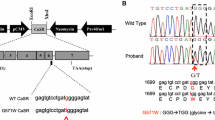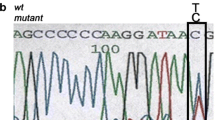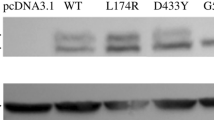Abstract
Gain-of-function mutations of the extracellular calcium (Ca2+e)-sensing receptor (CaR) have been identified in patients with familial and sporadic hypercalciuric hypocalcaemia. We describe a patient with sporadic severe hypercalciuric hypocalcaemia with undetectable or very low levels of serum parathyroid hormone, carrying a de novo heterozygous missense mutation (F821L), localized in the sixth transmembrane domain of CaR. Analysis of in vitro functional properties of the mutant receptor to measure Ca2+e-evoked changes in intracellular Ca2+ revealed a leftward shift in the concentration-response curve for the mutant compared to wild-type receptor. Conclusion:the F821L mutation is therefore a novel gain-of-function mutation which can cause severe hypoparathyroidism. Thiazide diuretics lowered urinary calcium excretion of the patient treated with calcium supplementation and 1α-hydroxyvitamin D3.


Similar content being viewed by others
Abbreviations
- Ca2+e:
-
extracellular calcium
- Ca2+i:
-
intracellular calcium
- CaR :
-
calcium-sensing receptor
- PTH :
-
parathyroid hormone
References
Bai M, Quinn S, Trivedi S, Kifor O, Pearce SHS, Pollak MR, Krapcho K, Hebert SC, Brown EM (1996) Expression and characterization of inactivating and activating mutations in the human Ca2+-sensing receptor. J Biol Chem 271: 19537–19545
Bai M, Pearce SHS, Kifor O, Trivedi S, Stauffer UG, Thakker RV, Brown EM, Steinmann B (1997) In vivo and in vitro characterization of neonatal hyperparathyroidism resulting from a de novo, heterozygous mutation in the Ca2+-sensing receptor gene: normal maternal calcium homeostasis as a cause of secondary hyperparathyroidism in familial benign hypocalciuric hypercalcemia. J Clin Invest 99: 88–96
Baron J, Winer KK, Yanovski JA, Cunningham AW, Laue L, Zimmerman D, Cutler GB Jr (1996) Mutations in the Ca2+-sensing receptor gene cause autosomal dominant and sporadic hypoparathyroidism. Hum Mol Genet 5: 601–606
Brown EM, Gamba G, Riccardi D, Lombardi M, Butters R, Kifor O, Sun A, Hediger MA, Lytton J, Hebert SC (1993) Cloning and characterization of an extracellular Ca2+-sensing receptor from bovine parathyroid. Nature 366: 575–580
Brown EM, Pollak MR, Seidman CE, Seidman JG, Chou YHW, Riccardi D, Hebert SC (1995) Calcium-ion-sensing cell surface receptors. N Engl J Med 333: 234–240
Cetani F, Pardi E, Borsari S, Tonacchera M, Morabito E, Pinchera A, Marcocci C (2003) Two Italian kindreds with familial hypocalciuric hypercalcemia caused by loss-of-function mutations in the calcium-sensing receptor (CaR) gene: functional characterization of a novel CaR missense mutation. Clin Endocrinol 58: 199–206
Chattopadhyay N, Mithal A, Brown EM (1996) The calcium-sensing receptor: a window into the physiology and pathophysiology of mineral ion metabolism. Endocr Rev 17: 289–307
Conley YP, Finegold DN, Peters DG, Cook JS, Oppenheim DS, Ferrell RE (2000) Three novel activating mutations in the calcium-sensing receptor responsible for autosomal dominant hypocalcemia. Mol Genet Metab 71: 591–598
D’Souza-Li L, Canaff L, Janicic N, Cole DE, Hendy GN (2001) An acceptor splice site mutation in the calcium-sensing receptor (CASR) gene in familial hypocalciuric hypercalcemia and neonatal severe hyperparathyroidism. Hum Mutat 18: 411–421
D’Souza-Li L, Yang B, Canaff L, Bai M, Hanley DA, Bastepe M, Salisbury SR, Brown EM, Cole DE, Hendy GN (2002) Identification and functional characterization of novel calcium-sensing receptor mutations in familial hypocalciuric hypercalcemia and autosomal dominant hypocalcemia. J Clin Endocrinol Metab 87: 1309–1318
De Luca F, Ray K, Mancillia EE, Fan GF, Winer KK, Gore P, Spiegel AM, Baron J (1997) Sporadic hypoparathyroidism caused by de novo gain-of-function mutations of the Ca2+-sensing receptor. J Clin Endocrinol Metab 82: 2710–2715
Dreimane D, Hendy G, Alon U, Geffner M (2001) Normalization of serum calcium, phosphorus, and magnesium with homeopathic PTH in a child with hypocalcemic hypercalciuria (HCHC) and a mutation of the calcium-sensing receptor gene (abstract). Proc 83rd Annual Meeting of The Endocrine Society, Denver, P3–125
Hirai H, Nakajima S, Miyauchi A, Nishimura K, Shimizu N, Shima M, Michigami T, Ozono K, Okada S (2001) A novel activating mutation (C129S) in the calcium-sensing receptor gene in a Japanese family with autosomal dominant hypocalcemia. J Hum Genet 46: 41–45
Jap TS, Wu YC, Jenq SF, Won GS (2001) A novel mutation in the calcium-sensing receptor gene in a Chinese subject with persistent hypercalcemia and hypocalciuria. J Clin Endocriol Metab 86: 13–15
Lienhardt A, Garabedian M, Bai M, Sinding C, Zhang Z, Lagarde JP, Boulesteix J, Rigaud M, Brown EM, Kottlet ML (2000) A large homozygous in-frame deletion within the calcium-sensing receptor’s carboxylterminal cytoplasmic tail that causes autosomal dominant hypocalcemia. J Clin Endocrinol Metab 85: 1695–1702
Lienhardt A, Bai M, Lagarde J-P, Rigaud M, Zhang Z, Jiang Y, Kottler M-L, Brown EM, Garabedian M (2001) Activating mutations of the calcium-sensing receptor: management of hypocalcemia. J Clin Endocrinol Metab 86: 5313–5323
Lovlie R, Eiken HG, Sorheim JI, Boman H (1996) The Ca2+-sensing receptor gene (PCAR1) mutation T151M in isolated autosomal dominant hypoparathyroidism. Hum Genet 98: 129–133
Mancillia EE, De Luca F, Ray K, Winer KK, Fan G-F, Baron J (1997) A Ca2+-sensing receptor mutation causes hypoparathyroidism by increasing receptor sensitivity to Ca2+ and maximal signal transduction. Pediatr Res 42: 443–447
Nagase T, Murakami T, Tsukada T, Kitamura R, Chikatsu N, Takeo H, Takata N, Yasuda H, Fukumoto S, Tanaka Y, Nagata N, Yamaguchi K, Akatsu T, Yamamoto M (2002) A family of autosomal dominant hypocalcemia with a positive correlation between serum calcium and magnesium: identification of a novel gain of function mutation (Ser(829)Phe) in the calcium-sensing receptor. J Clin Endocrinol Metab 87: 2681–2687
Pearce SHS, Trump D, Wooding C, Besser GM, Chew SL, Grant DB, Heath DA, Hughes IA, Paterson CR, Whyte MP, Thakker RV (1995) Calcium-sensing receptor mutations in familial benign hypercalcemia and neonatal hyperparathyroidism. J Clin Invest 96: 2683–2692
Pearce SHS, Bai M, Quinn SJ, Kifor O, Brown EM, Thakker RV (1996) Functional characterization of calcium-sensing receptor mutations expressed in human embryonic kidney cells. J Clin Invest 98: 1860–1866
Pearce SHS, Williamson C, Kifor O, Bai M, Coulthard MG, Davis M, Lewis-Barned N, McCredie D, Powell H, Kendall-Taylor P, Brown EM, Thakker RV (1996) A familial syndrome of hypocalcemia with hypercalciuria due to mutations in the calcium-sensing receptor. N Engl J Med 335: 1115–1122
Pollak MR, Brown EM, Chou YW, Hebert SC, Marx SJ, Steinmann B, Levi T, Seidman CE, Seidman JG (1993) Mutations in the human Ca2+ sensing receptor gene cause familial hypocalciuric hypercalcemia and neonatal severe hyperparathyroidism. Cell 75: 1297–1303
Pollak MR, Brown EM, Estep HL, McLaine PN, Kifor O, Park J, Hebert SC, Seidman CE, Seidman JG (1994) Autosomal dominant hypocalcemia caused by a Ca(2+)-sensing receptor gene mutation. Nat Genet 8: 303–307
Riccardi D, Park J, Lee WS, Gamba G, Brown EM, Hebert SC (1995) Cloning and functional expression of a rat kidney extracellular calcium-sensing receptor. Proc Natl Acad Sci USA 92: 131–135
Sato K, Hasegawa Y, Nakae J, Nanao K, Takahashi I, Tajima T, Shinohara N, Fujieda K (2002) Hydrochlorothiazide effectively reduces urinary calcium excretion in two Japanese patients with gain-of-function mutations of the calcium-sensing receptor gene. J Clin Endocrinol Metab 87: 3068–3073
Shiohara M, Uskokovic M, Hisatake J, Hisatake Y, Koike K, Komiyama A, Koeffler HP (2001) 24-oxo metabolites of vitamin D3 analogues: disassociation of their prominent antileukemic effects from their lack of calcium modulation. Cancer Res 61: 3361–3368
Vargas-Poussou R, Huang C, Hulin P, Houillier P, Jeunemaitre X, Paillard M, Planelles G, Dechaux M, Miller RT, Antignac C (2002) Functional characterization of a calcium-sensing receptor mutation in severe autosomal dominant hypocalcemia with a Bartter-like syndrome. J Am Soc Nephrol 13: 2259–2266
Watanabe S, Fukumoto S, Chang H, Takeuchi Y, Hasegawa Y, Okazaki R, Chikatsu N, Fujita T (2002) Association between activating mutations of calcium-sensing receptor and Bartter’s syndrome. Lancet 360: 692-694
Watanabe T, Bai M, Lane CR, Matsumoto S, Minamitani K, Minagawa M, Niimi H, Brown EM, Yasuda T (1998) Familial hypoparathyroidism: identification of a novel gain of function mutation in transmembrane domain 5 of the calcium-sensing receptor. J Clin Endocrinol Metab 83: 2497–2502
Winer KK, Yanovski JA, Sarani B, Cutler GB (1998) A randomized, cross-over trial of once-daily versus twice-daily parathyroid hormone 1–34 in treatment of hypoparathyroidism. J Clin Endocrinol Metab 83: 3480–3486
Yamamoto M, Akatsu T, Nagase T, Ogata E (2000) Comparison of hypocalcemic hypercalciuria between patients with idiopathic hypoparathyroidism and those with gain-of-function mutations in the calcium-sensing receptor: is it possible to differentiate the two disorders? J Clin Endocrinol Metab 85: 4583–4591
Yasuda T, Niimi H (1997) Hypoparathyroidism and pseudohypoparathyroidism. Acta Paediatr Jpn 39: 485–490
Author information
Authors and Affiliations
Corresponding author
Rights and permissions
About this article
Cite this article
Shiohara, M., Mori, T., Mei, B. et al. A novel gain-of-function mutation (F821L) in the transmembrane domain of calcium-sensing receptor is a cause of severe sporadic hypoparathyroidism. Eur J Pediatr 163, 94–98 (2004). https://doi.org/10.1007/s00431-003-1331-7
Received:
Accepted:
Published:
Issue Date:
DOI: https://doi.org/10.1007/s00431-003-1331-7




